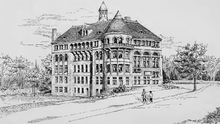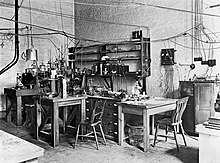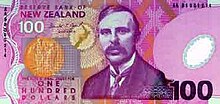Ernest Rutherford
Ernest Rutherford, 1st Baron Rutherford of Nelson (born August 30, 1871 in Spring Grove near Nelson , New Zealand , † October 19, 1937 in Cambridge , United Kingdom ) was a British physicist who received the 1908 Nobel Prize in Chemistry . Rutherford is considered one of the most important experimental physicists .
In 1897, Rutherford recognized that the ionizing radiation from uranium consists of several types of particles. In 1902 he hypothesized that chemical elements change into elements with a lower atomic number through radioactive decay. In 1903 he differentiated radioactivity into alpha radiation , beta radiation and gamma radiation according to their increasing penetration capacity and introduced the term half-life . This work was awarded the Nobel Prize in Chemistry in 1908 .
His best-known contribution to atomic physics is Rutherford's atomic model , which he derived from his experiments in scattering alpha particles on gold foil in 1911 . Rutherford expanded the atomic model of Thomson , who had assumed a uniform mass distribution.
Rutherford demonstrated experimentally for the first time in 1917 that irradiation with alpha particles can convert one atomic nucleus (in his case nitrogen ) into another (in his case into the next heavier element oxygen ). During these experiments he discovered the proton . Under his guidance, John Cockcroft and Ernest Walton "smashed" an atomic nucleus with artificially accelerated particles; Lithium bombarded with protons was converted into two alpha particles, i.e. helium nuclei. Another scientist in Cambridge, James Chadwick , succeeded in 1932 in experimentally demonstrating the neutron , which Rutherford had theoretically postulated years earlier.
Live and act
Origin and education
Ernest Rutherford was the fourth of twelve children of James Rutherford (1838-1928) and his wife Martha Thompson (around 1843-1935). His parents immigrated to New Zealand as a child . From Spring Grove , the family moved to Foxhill in 1876 . From March 1877, Rutherford attended the Primary School led by Henry Ladley there . In 1883 the family moved on to Havelock , where their father ran a flax mill he built on the Ruakaka River . For economic reasons, the family had to move again five years later, this time to Pungarehu on New Zealand's North Island . Supported by a grant from the Marlborough Education Board, Rutherford attended Nelson College from 1887 to 1889 . There he played in the rugby team and was head boy in 1889. His interest in mathematics and science was encouraged by his teacher William Still Littlejohn (1859-1933).
From February 1890, Rutherford studied at Canterbury College in Christchurch . There, the professor of mathematics and natural philosophy Charles Henry Herbert Cook (1843-1910) promoted Rutherford's mathematical talent, while the professor of chemistry Alexander William Bickerton (1842-1929), who also taught physics, aroused Rutherford's interest in physics. In 1892 Rutherford passed the exams for the Bachelor of Arts , in 1893 he earned a Master of Arts degree and a year later a Bachelor of Science degree . Rutherford's first research dealt with the influence of high frequency Hertzian waves on the magnetic properties of iron and was published in the Transactions of the New Zealand Institute .
During this time, Rutherford lived in the house of the widowed Mary Kate De Renzy Newton, a secretary for the Woman's Christian Temperance Union . There he met her daughter, his future wife Mary "May" Georgina Newton (1876–1945).
Rutherford applied in 1894 for the New Zealand place for an " 1851 Exhibition Scholarship ", a scholarship funded from the surpluses of the Great Exhibition of 1851 in London. He was defeated with his application to the chemist James Scott Maclaurin (1864-1939) from Auckland University College . When Maclaurin did not accept the £ 150 scholarship intended for a study visit to Great Britain, Rutherford was awarded it as the second applicant.
On August 1, 1895, Rutherford left New Zealand on a steamship from Wellington . During a stopover, he demonstrated his Hertzian wave detector to William Henry Bragg at the University of Adelaide and received a letter of recommendation from Bragg. In October 1895 Rutherford began his work at the Cavendish Laboratory of the University of Cambridge , directed by Joseph John Thomson . Initially, he was concerned with improving the sensitivity of his detector, which he could soon use to detect radio waves at a distance of about half a mile. Thomson, who quickly recognized Rutherford's experimental talent, invited Rutherford at the beginning of the Easter semester in 1896 to help him investigate the electrical conductivity of gases . They used the X-rays discovered a few months earlier to trigger conductivity in the gases. Rutherford developed the experimental techniques to measure the rate of recombination and the velocities of the ions formed under the action of the X-rays . In the following years Rutherford continued these experiments using ultraviolet radiation .
After two years in Cambridge, Rutherford received his "BA Research Degree" in 1897. Through Thomson's advocacy, he was awarded the 250 pound per year Coutts Trotter Fellowship of Trinity College in 1898 , which enabled Rutherford to spend another year at Cambridge.
Professor in Montreal, Manchester and Cambridge

In 1898 he received a call to the McGill University in Montreal ( Canada ), where he worked until 1907. For the research he carried out during this time, he received the Nobel Prize in Chemistry in 1908 .
He then began to teach at the University of Manchester in England , where he worked with future Nobel Prize winners such as Niels Bohr and Patrick Blackett , among others .
During the First World War , he traveled to the USA in 1917 with Henri Abraham and Charles Fabry to discuss the issue of anti-submarine defense .
In 1919 he went to Cambridge as a professor , where he was director of the Cavendish Laboratory . 1921 his work appeared Nuclear Constitution of Atoms (dt .: About the core structure of atoms) . From 1925 to 1930 he was President of the Royal Society .
In 1933 he assisted William Henry Beveridge in founding the Academic Assistance Council (AAC, now the Council for Assisting Refugee Academics ), of which he became the first president.
In 1934, together with Mark Oliphant and Paul Harteck, he succeeded in the discovery of tritium and the first targeted implementation of a nuclear fusion reaction .
Rutherford's ashes were buried in Westminster Abbey in London near the grave of Isaac Newton .
Awards and recognition

Rutherford is one of the world's most honored scientists. The British crown ennobled him in 1914 as a Knight Bachelor , accepted him in 1925 in the Order of Merit and raised him to hereditary peer in 1931 as Baron Rutherford of Nelson , of Cambridge in the County of Cambridge .
A 1,906 newly discovered and Willy Marckwald described uranyl -mineral received his honor the name rutherfordine . In addition to the Nobel Prize in Chemistry, which was awarded to him in 1908, Rutherford received numerous scientific and academic prizes and honors. The Royal Society awarded him the Rumford Medal in 1904 and honored Rutherford in 1922 with their highest honor, the Copley Medal in gold. The Accademia delle Scienze di Torino honored him in 1908 with the award of the Bressa Prize (Premio Bressa). The Columbia University gave Rutherford every five years awarded Barnard Medal for the year 1910th
In 1906 he was elected to the Academy of Sciences in Göttingen , in 1911 to the National Academy of Sciences and in 1915 to the American Academy of Arts and Sciences . He received the Franklin Medal of the Franklin Institute in Philadelphia in 1924 , the Albert Medal of the Royal Society of Arts in 1928 and the Faraday Medal of the Institution of Electrical Engineers in 1930 . In 1921 he was elected an Honorary Fellow of the Royal Society of Edinburgh . In 1922 he became a corresponding and in 1925 honorary member of the Academy of Sciences of the USSR . In 1932 he was made an honorary member of the German Academy of Natural Scientists Leopoldina .
The Council of the Physical Society of London founded the Rutherford Memorial Lecture in 1939, which resulted in the Rutherford Medal and Prize in 1965 .
In mid-1946, Edward Condon and Leon Francis Curtiss (1895-1983) proposed by the US National Bureau of Standards to introduce a new physical unit Rutherford with the unit symbol rd for measuring activity , but this did not prevail.
On November 3, 1992, the Bank of New Zealand issued a $ 100 bill with a portrait of Rutherford. In 1997, element 104 was finally named rutherfordium in his honor .
In the 2005 New Zealand's Top 100 History Makers series , Rutherford was voted the most influential New Zealander in history. A memorial was built in his place of birth and his former primary school in Foxhill is keeping his memory alive with the Rutherford Memorial Hall.
A Mars crater was named after him in 1973 and a moon crater in 1976. Rutherford Ridge in Antarctica has been named after him since 2008, and an asteroid has been named after him since 2021: (5311) Rutherford .
Fonts (selection)
Books
Original English editions
- Radio activity . 1st edition, At the University Press, Cambridge 1904 ( online ); 2nd edition, 1905 ( online ).
- Radioactive Transformations . Archibald Constable & Co., London 1906 ( online ).
- Radioactive Substances and Their Radiations . At the University Press, Cambridge 1913 ( online ).
- Radiations From Radioactive Substances . University Press, Cambridge 1930 (with James Chadwick and Charles Drummond Ellis).
- Artificial Transmutation of the Elements. Being the Thirty-fifth Robert Boyle Lecture . (= Robert Boyle Lecture, Volume 35), H. Milford, Oxford University Press 1933
- The Newer Alchemy . University Press, Cambridge 1937.
German translations
- The radioactivity . Authorized edition supplemented with the assistance of the author by Emil Aschkinass, Julius Springer, Berlin 1907 ( online ).
- Radioactive conversions . Translated by Max Levin, Friedrich Vieweg and Son, Braunschweig 1907 ( online ).
- Radioactive substances and their radiation . Translated by Erich Marx, Akademische Verlagsgesellschaft, Leipzig 1913.
- About the core structure of the atoms. Baker lecture . Authorized translation by Else Norst, Hirzel, Leipzig 1921.
Magazine articles
- Uranium Radiation and the Electrical Conduction Produced by It . In: Philosophical Magazine . 5th episode, volume 47, number 284, 1899, pp. 109-163 ( doi: 10.1080 / 14786449908621245 ).
- A Radio-active Substance emitted from Thorium Compounds . In: Philosophical Magazine . 5th episode, volume 49, number 296, 1900, pp. 1-14 ( doi: 10.1080 / 14786440009463821 ).
- Radioactivity produced in Substances by the Action of Thorium Compounds . In: Philosophical Magazine . 5th episode, volume 49, number 297, 1900, pp. 161-192 ( doi: 10.1080 / 14786440009463832 ).
- Comparison of the Radiations from Radioactive Substances . In: Philosophical Magazine . 6th episode, volume 4, number 19, 1902, pp. 1-23 (with Harriet T. Brooks ; doi: 10.1080 / 14786440209462814 ).
- The Cause and Nature of Radioactivity. - Part I . In: Philosophical Magazine . 6th episode, volume 4, number 21, 1902, pp. 370-396 (with Frederick Soddy ; doi: 10.1080 / 14786440209462856 ).
- The Cause and Nature of Radioactivity. - Part II . In: Philosophical Magazine . 6th episode, volume 4, number 21, 1902, pp. 569-585 (with Frederick Soddy; doi: 10.1080 / 14786440209462881 ).
- The Magnetic and Electric Deviation of the Easily Absorbed Rays from Radium . In: Philosophical Magazine . 6th episode, volume 5, number 25, 1903, pp. 177-187 ( doi: 10.1080 / 14786440309462912 ).
- A Comparative Study of the Radioactivity of Radium and Thorium . In: Philosophical Magazine . 6th episode, volume 5, number 28, 1903, pp. 445-457 (with Frederick Soddy; doi: 10.1080 / 14786440309462943 ).
- Condensation of the Radioactive Emanations . In: Philosophical Magazine . 6th episode, volume 5, number 29, 1903, pp. 561-576 (with Frederick; doi: 10.1080 / 14786440309462959 ).
- Bakerian Lecture. Nuclear Constitution of Atoms. In : Proceedings of the Royal Society of London / A. 97, number 686, 1920, pp. 374-400 ( doi: 10.1098 / rspa.1920.0040 ).
literature
- Edward Andrade: Rutherford and the Nature of the Atom . (= Science Study Series . Number 29). Heinemann, 1964.
- Edward Andrade: Rutherford and the Atom. The beginning of the new physics . Translated from the American into German by Klaus Prost, Desch, Munich 1965.
- Lawrence Badash (Ed.): Rutherford and Boltwood. Letters on radioactivity . Yale University Press, New Haven 1969.
- Lawrence Badash: Rutherford Correspondence Catalog . American Institute of Physics, New York 1974.
- John Campbell: Rutherford. Scientist Supreme . AAS Publications, Christchurch 1999, ISBN 0-473-05700-X .
- John Campbell: Rutherford's Ancestors . AAS Publications, Christchurch 1996, ISBN 0-473-03858-7 .
- James Chadwick (Ed.): The Collected Papers of Lord Rutherford of Nelson . 3 volumes, George Allen and Unwin, London 1962–1965.
- Arthur Eve: Rutherford . Cambridge University Press, Cambridge 1939.
- Mark Oliphant: Rutherford. Recollections of the Cambridge Days . Elsevier, Amsterdam 1972, ISBN 0-444-40968-8 .
- Richard Reeves: Force of Nature: The Frontier Genius of Ernest Rutherford . WW Norton & Company, 2008, ISBN 978-0-393-33369-5 .
- David Wilson: Rutherford. Simple genius . MIT Press, Cambridge 1983, ISBN 0-262-23115-8 .
Web links
- Literature by and about Ernest Rutherford in the catalog of the German National Library
- Newspaper article about Ernest Rutherford in the 20th century press kit of the ZBW - Leibniz Information Center for Economics .
- Information from the Nobel Foundation on the 1908 award ceremony for Ernest Rutherford
- Entry about Lord Ernest Rutherford of Nelson in the database of the Wilhelm Exner Medal Foundation .
- Short biography at the Public Broadcasting Service
- Brian Sweeney, Jacqueline Owens: Ernest Rutherford: Atom Man
Individual evidence
- ^ Nobel Prize for Chemistry 1908, original lecture
- ^ Thaddeus J. Trenn: Rutherford on the Alpha-Beta-Gamma Classification of Radioactive Rays. Isis Vol. 67 (1976) p. 61ff doi.org/10.1086/351545
- ↑ John Campbell: Rutherford's Ancestors . 1996, p. 12.
- ↑ John Campbell: Rutherford's Ancestors . 1996, p. 20.
- ↑ John Campbell: Rutherford's Ancestors . 1996, p. 39.
- ^ WJ Gardner: Cook, Charles Henry Herbert . In: Dictionary of New Zealand Biography , accessed March 4, 2013.
- ^ HN Parton: Bickerton, Alexander William . In: Dictionary of New Zealand Biography , accessed March 4, 2013.
- ^ Brian R. Davis: Maclaurin, James Scott . In: Dictionary of New Zealand Biography , accessed March 4, 2013.
- ↑ John Campbell: Rutherford. Scientist Supreme . 1999, p. 192.
- ↑ Arthur Eve: Rutherford . 1939, p. 13.
- ↑ Sungook Hong: Wireless: From Marconi's Black Box to the Audion . MIT Press, 2001, ISBN 0-262-08298-5 , pp. 13-16.
- ↑ John Campbell: Rutherford. Scientist Supreme . 1999, p. 246.
- ↑ Johannes-Geert Hagmann: How physics made itself heard - American physicists engaged in "practical" research during the First World War . Physik Journal 14 (2015) No. 11, pp. 43–46.
- ^ History. cara1933.org, archived from the original on May 7, 2015 ; accessed on September 4, 2013 .
- ↑ Rutherford, Oliphant, Paul Harteck: Transmutation effects observed with heavy hydrogen, Proc. Roy. Soc. A, Vol. 144, 1934, pp. 692-703, and under the same title, Nature, Vol. 133, 1934, p. 413
- ^ The discovery of DD fusion , EuroFusion, 2010
- ^ PP O'Shea: Ernest Rutherford. His Honors and Distinctions . In: Notes and Records of the Royal Society of London . Volume 27, number 1, 1972, p. 67 ( doi: 10.1098 / rsnr.1972.0009 ).
- ↑ London Gazette . No. 28806, HMSO, London, February 24, 1914, p. 1546 ( PDF , accessed October 1, 2013, English).
- ^ London Gazette (Supplement). No. 33007, HMSO, London, January 1, 1925, p. 3 ( PDF , accessed October 1, 2013, English).
- ^ London Gazette (Supplement). No. 33675, HMSO, London, January 1, 1931, p. 1 ( PDF , accessed October 1, 2013, English).
- ↑ Relazione sul XV Premio Bressa . In: Atti della Reale Accademia delle scienze di Torino . Volume 43, 1907-1908, pp. 579-586 ( online ).
- ^ Report of the Committee on the Bernard Medal . In: Report of the National Academy of Sciences for the Year 1910 . United States Government Printing Office , Washington 1911, pp. 14-15 ( online ).
- ^ Fellows Directory. Biographical Index: Former RSE Fellows 1783–2002. (PDF file) Royal Society of Edinburgh, accessed April 5, 2020 .
- ^ Christel Dell, Danny Weber, Thomas Wilde: The Academy Awards . Honorary membership. In: Jörg Hacker (Ed.): German Academy of Natural Scientists Leopoldina . Structure and members. German Academy of Natural Scientists Leopoldina eV, Halle (Saale) 2015, p. 353 ( leopoldina.org [PDF; accessed September 25, 2016]).
- ^ Edward Uhler Condon, Leon Francis Curtiss: New Units for the Measurement of Radioactivity . In: Physical Review . Volume 69, number 11-12, 1946, pp. 672-673 ( doi: 10.1103 / PhysRev.69.672 )
- ^ John Barry: Currency trends and developments . In: Reserve Bank of New Zealand Bulletin . Volume 57, number 4, 1994, p. 352 ( PDF ).
- ^ Helga Neubauer: Foxhill / Brightwater . In: The New Zealand Book . 1st edition. NZ Visitor Publications , Nelson 2003, ISBN 1-877339-00-8 , pp. 1011 f .
- ↑ Ernest Rutherford in the Gazetteer of Planetary Nomenclature of the IAU (WGPSN) / USGS
- ↑ Ernest Rutherford in the Gazetteer of Planetary Nomenclature of the IAU (WGPSN) / USGS
| personal data | |
|---|---|
| SURNAME | Rutherford, Ernest |
| ALTERNATIVE NAMES | Rutherford, Ernest, 1st Baron Rutherford of Nelson; Rutherford, Sir Ernest |
| BRIEF DESCRIPTION | New Zealand nuclear physicist, Nobel laureate in chemistry |
| BIRTH DATE | August 30, 1871 |
| PLACE OF BIRTH | Spring Grove at Nelson |
| DATE OF DEATH | October 19, 1937 |
| PLACE OF DEATH | Cambridge |


